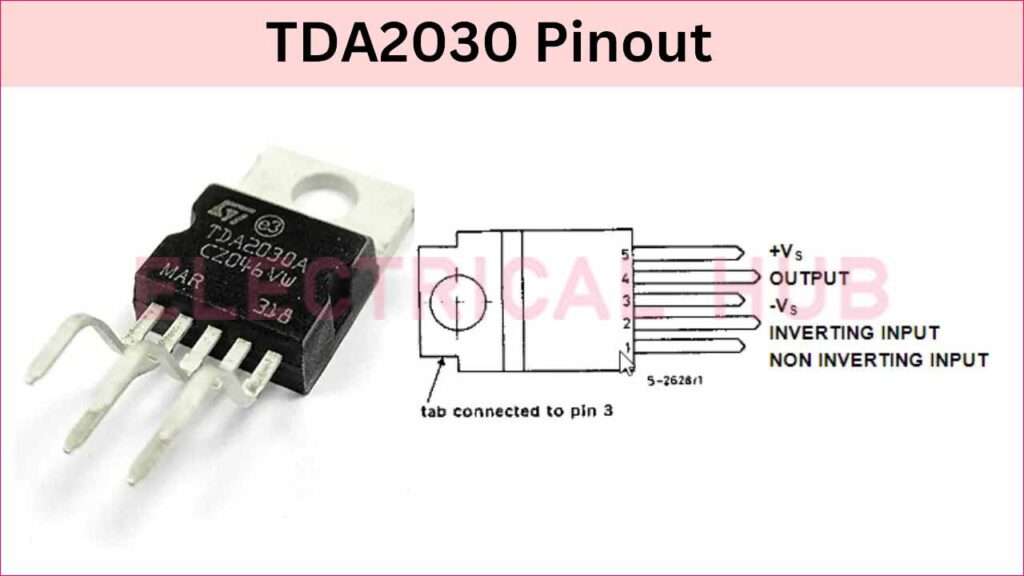TDA 2030: A Complete Guide to the Popular Audio Amplifier IC
Introduction to TDA 2030
TDA 2030 is a widely used audio amplifier IC known for its high performance and low distortion. This monolithic integrated circuit is designed for class-AB amplifier applications, delivering high output power with minimal external components. It is commonly used in audio amplifier circuits, subwoofers, and small home theater systems.
Table of Contents
Table of Contents

This article will cover how TDA2030 works, its technical specifications, circuit design, power ratings, and comparisons with other amplifier ICs like TDA2050, LM1875, and TDA2030A.
Technical Specifications of TDA 2030
TDA 2030 is an operational amplifier-based power amplifier IC with the following key specifications:
- Operating Voltage: 6V to 36V (dual supply: ±3V to ±18V)
- Output Power: Up to 18W with ±15V supply
- Output Current: 3.5A peak
- Harmonic Distortion: Less than 0.5%
- Operating Class: Class-AB
- Protection Features: Short-circuit and thermal protection
- Efficiency: High efficiency with minimal heat dissipation
How TDA2030 Works
TDA2030 operates as a class-AB amplifier, meaning it combines the efficiency of class-B with the low distortion of class-A amplifiers. It amplifies low-level audio signals and drives speakers, headphones, or subwoofers.
A basic audio amplifier using TDA2030 consists of:
- Power Supply: A ±15V dual power supply is commonly used
- Input Stage: Small capacitor-coupled audio signals
- Feedback Network: Determines gain and stability
- Output Stage: Delivers amplified signal to the speaker
TDA 2030 Circuit Designs
1. Basic Audio Amplifier Circuit Using TDA 2030
A simple TDA2030 amplifier circuit requires the following components:
- TDA 2030 IC
- Power supply (±15V DC)
- Resistors (10kΩ, 100Ω, 1Ω, etc.)
- Capacitors (Electrolytic: 100µF, Ceramic: 0.1µF)
- Speaker (4Ω or 8Ω)
The circuit configuration includes a gain control resistor to adjust the amplification level.
2. TDA 2030 Bridge Amplifier Circuit
A TDA 2030 bridge amplifier uses two TDA 2030 ICs to double the output power. The key advantages include:
- Higher power output (up to 35W with a ±18V supply)
- Better efficiency and low distortion
- Ideal for subwoofers and stereo applications
TDA2030 Power Ratings
Here are the typical values:
- Operating Voltage: ±15V to ±18V
- Maximum Voltage: ±22V
- Output Power: 18W in a single-ended configuration and 35W in bridge mode
Comparisons and Equivalent ICs
TDA2030 vs TDA2050
- TDA2030: 18W output power
- TDA2050: 32W output power (higher power, better efficiency)
- TDA2050 has lower distortion at high power
Can I replace TDA2030 with TDA2050?
Yes, but TDA2050 requires higher voltage and current capacity.
TDA2030 vs LM1875
- TDA2030: 18W output, lower cost
- LM1875: 20W output, higher audio fidelity
- LM1875: has better thermal stability
Can I replace TDA2030 with LM1875?
Yes, but LM1875 has higher voltage requirements.
TDA2030 vs TDA2030A
- Difference between TDA2030 and TDA2030A:
- TDA2030A is an improved version with slightly higher power handling
- Lower distortion in high-frequency response
TDA2030 vs TDA2003
- TDA2030: Used in home audio amplifiers
- TDA2003: Designed for car audio systems
- TDA2003 has a lower power rating than TDA2030
TDA2030 vs TPA3116
- TDA2030: Analog class-AB amplifier
- TPA3116: Digital class-D amplifier
- TPA3116 is more efficient, but TDA2030 offers better analog sound quality
TDA2030 Power Supply Configurations
Single vs Dual Power Supply
- TDA2030 dual power supply (±15V) allows better performance and symmetric output waveforms
- Single power supply (0V to 30V) can be used but needs a DC blocking capacitor
TDA2030 with Transistor for Higher Power
To boost the power output of TDA2030, it can be paired with power transistors (BD139, BD140, TIP41, TIP42).
Advantages of using TDA2030 with transistor:
- Higher output power (up to 50W)
- Better thermal stability
- Reduced load on the IC
Equivalent ICs for TDA2030
If TDA 2030 is unavailable, the following ICs can be used:
- TDA2050 (higher power)
- LM1875 (better sound quality)
- TDA2040 (similar performance)
Equivalent TDA 2030 circuits can also use discrete transistor-based designs for better flexibility.
Datasheet and Pin Configuration
Data Pin IC TDA2030
The datasheet IC TDA 2030 provides details on:
- Pin 1: Non-inverting input
- Pin 2: Inverting input
- Pin 3: Ground (or negative voltage in dual supply)
- Pin 4: Negative supply voltage (-Vcc)
- Pin 5: Output
The datasheet ic TDA2030 also includes recommended circuit configurations for optimal performance.
Conclusion
TDA 2030 is a versatile, cost-effective audio amplifier IC that is widely used in home audio systems. It offers 18W of output power, operates in class-AB mode, and supports both single and dual power supply configurations.
For users looking for higher power output, alternatives like TDA2050 or LM1875 can be considered. Additionally, bridging TDA2030 or using it with transistors can significantly boost its performance.
This guide provides all the necessary details on how TDA2030 works, circuit design, power ratings, and comparisons with other ICs, making it a comprehensive resource for electronics enthusiasts and engineers.
Related Resources:
- Differential OP AMP Calculator
- Differential Op Amp
- Op Amp Interview Questions
- LM358 Datasheet
- Op Amp Circuits
Follow Us on Social:
Subscribe our Newsletter on Electrical Insights to get the latest updates in Electrical Engineering.
TDA2030, #AudioAmplifier, #TDA2030Circuit, #TDA2030IC, #TDA2030Amplifier, #TDA2030Bridge, #TDA2030VsTDA2050, #TDA2030VsLM1875, #TDA2030Equivalent, #TDA2030Datasheet, #TDA2030PowerSupply, #TDA2030Watt, #TDA2030Transistor, #TDA2030Comparison, #TDA2030Audio
